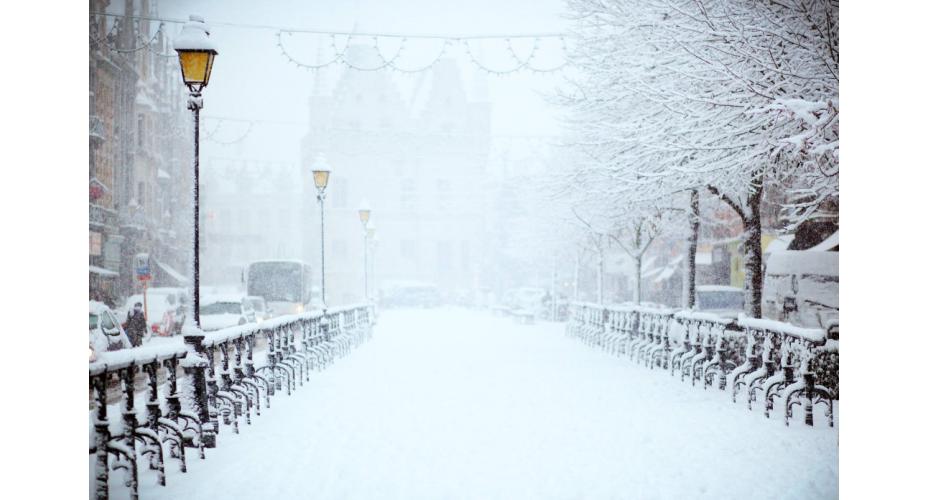
When the first winter snow blankets your city, there’s a short list of things you may feel inclined to do: brew hot cocoa, bake cookies, make a fire, or otherwise embrace the great (and heated) indoors. But what about a run? Just because it’s winter doesn’t mean all of your hard work over the summer has to go to waste.
Hear us out. The once-bustling sidewalks, parkways, and multi-use trails of our Northern cities tend to fall silent when snow, wind, and freezing temperatures blow into town. This leaves the intrepid all-weather runner with a tranquil urban playground ripe for boundless exploration and enjoyment.
Ready to ditch the treadmill this winter and take back your favorite routes? Good! We talked to winter running experts from three insanely chilly cities to find out how anyone can thrive in cold.
1. Dress for the Weather
 If you properly layer your clothing, you won’t have to worry about being cold. Luke Warmwater
If you properly layer your clothing, you won’t have to worry about being cold. Luke Warmwater
You’re not going to have any fun if you’re freezing the whole time. Apparel is crucial (or at least the ability to adjust your clothing to the condition). Jonathan Griffiths is the owner of Rochester Running Company in Rochester, New York, and an outfitter of the city’s unwavering winter running crowd.
"Running in Rochester in the wintertime is a different experience because of the amount of snow we get each year," Griffiths says. (In case you were wondering, it’s about 99 inches, on average.) “The best way to start is layering because you can always remove clothes if you wear too much.”
Griffiths recommends starting with a solid base layer to be worn under everything else, so make sure the material feels comfortable up against your skin. Wool is a common base layer fabric for its ability to keep you warm dry or wet, and don a set of base layer tights under your normal tights or pants on the coldest of days.
Next, scope out an outer shell jacket and a pair of shield pants or tights, which sales associate Megan Dedering of Minneapolis’ Mill City Running says is imperative in regulating your body temperature in the cold. "The most important thing is probably having a good tight or shield pant that blocks the wind," she says. “A lot of times those will be loose enough to where you can wear a pair of regular running tights. Same thing with a jacket that cuts the wind.”
If conditions are dry and cool but not freezing, Griffiths says runners can swap an outer shell for a long-sleeved shirt to wear over the base layer.
With the torso and extremities covered, you’ll want to make sure your feet are up for the task. Dedering recommends wool socks that are thicker than traditional running socks and excel at wicking moisture while keeping your toes cozy. And if your fingers get cold before the rest of your body, go with mittens over gloves. "Mittens are better because you can keep your fingers together," Dedering says. “A lot of running mittens will have a shield to be wind-resistant—in the winter, that can make a huge difference.”
And, like mother always told you, you lose a lot of body heat through your head, so make sure you’ve got a warm hat that covers your ears. In fact, if you’re going to run all winter, Griffiths says you should be prepared to cover all of the skin on your body. "Wearing something that goes over your wrist and ankles and having some kind of head wear is really important," he says. “Something scarf-like around your neck is usually advantageous if you’re trying to keep warm.”
2. Gear Up
 Add a few key pieces of gear to your routine to have many successful winter runs. Tom Gill
Add a few key pieces of gear to your routine to have many successful winter runs. Tom Gill
Warm clothes can keep you going, but you’ll be flailing about in the dark if you don’t make some simple yet crucial adjustments to your gear.
"We sell a lot of Yaktrax - you can put them on the bottom of any shoe. Those help with running in the snow and ice because they have spikes and wire coils for traction," Dedering says. Some winter-specific running shoes have extra sticky outsoles to keep you upright on the slick spots. “The material acts as a putty once it hits an ice patch,” Dedering says of the shoe.
You can’t avoid what you can’t see, which is why Griffiths recommends wearing a headlamp over your hat if you’re going out in the dark. And as sundown creeps earlier and earlier, being seen by drivers is super important.
"More and more clothing is having reflective elements built in," Griffiths says, adding that having reflective tights, pants, or shoes increase your chances of being seen by showing drivers you’re a bipedal moving object
3. Get Hyped
 Winter running can be a lot of fun! Dawn
Winter running can be a lot of fun! Dawn
The difference between a frozen-over nightmare and a winter wonderland is all about perspective, and if you’ve got the right mindset, the cold and snow can actually enhance the experience. "I personally enjoy winter running just because it almost turns your city into a bit of a trail without going too far," Griffiths says. “It makes the terrain a lot more complex when you have snow on the ground.”
Brian Croci leads a Tuesday night running group from Hansons Running Shop in Grosse Pointe, Michigan, near Detroit. He says there’s strength in numbers. "Our group is pretty good," Croci says. “If it’s in the 20s and it’s still decent out and there’s no terrible windchill, we still get a good little turnout.”
Croci says his wife has a proven trick to make it out the door each day. "She tells herself, ‘I’m only going to go out and run 10 minutes,’ and once she’s out and going for a few minutes, she’s going to keep going," he says.
Save some personal motivators, like your favorite pump-up song or a running movie, for the worst days. Springsteen’s *Born to Run *coupled with running flick *Chariots of Fire *should do the trick.
4. Your Running Form
 No more excuses - get out there! manyamoon
No more excuses - get out there! manyamoon
You’re standing at the door sweating through all these layers, physically and mentally primed to lay down a PR in six inches of snow. Before you go, remember the rules of running in the dark, snow, and ice.
"Take shorter strides if you can’t see, especially if you’re running over sidewalk and it’s dark out," Croci says. “Exaggerate your leg lift so you’re not catching a little patch of concrete, and obviously, bring lights, headlamps, or anything for you to be seen as well as allowing you to see.”
Is there ever a situation when you absolutely shouldn’t run outside? Of course - be smart about the weather and don’t let yourself get caught out in a dangerous situation. Croci says that runners who are looking to complete high-quality aerobic and anaerobic workouts might be better off on a treadmill or indoor track, as poor conditions could hamstring your workout (and because flat-out sprinting over ice is never a good idea).
Otherwise, lace up and get out there!
Superfeet RUN Insoles can take your winter from from flat to fantastic. Responsive and lightweight, our run-specific insoles alleviate pain, reduce foot fatigue and help you do more of what you love, even when the temperature drops well below freezing.

